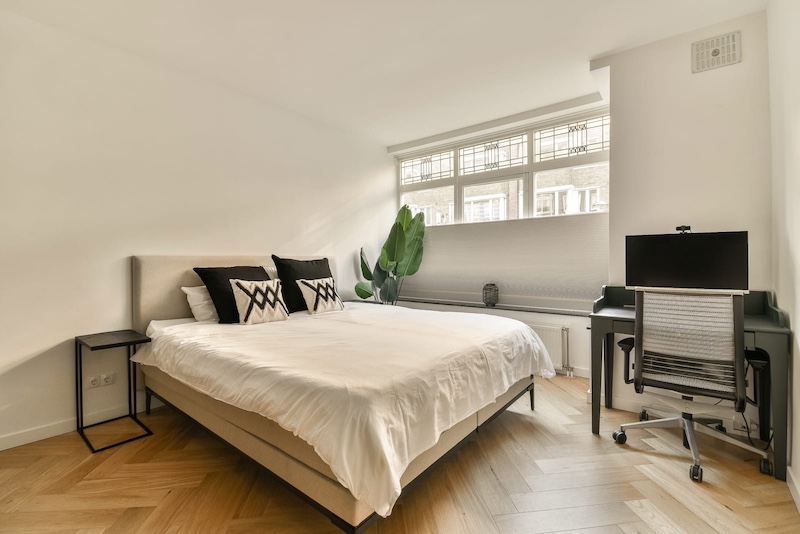Transforming a living room into a bedroom can breathe new life into your home and maximize your living space. This conversion allows homeowners to adapt their homes to changing needs without major renovations. Careful planning and thoughtful design choices can turn a living area into a cozy, functional bedroom.
The process involves assessing the available space, considering privacy needs, and selecting appropriate furniture and decor. Key steps include creating proper lighting, ensuring adequate storage, and incorporating room dividers if necessary. With creativity and strategic planning, even small living rooms can become comfortable sleeping quarters.
Repurposing a living room as a bedroom offers flexibility for growing families, home offices, or guest accommodations. This transformation can increase a home’s versatility and potentially its value. By following some practical guidelines, homeowners can successfully execute this room conversion and create a welcoming new bedroom space.
Assessing and Preparing the Space
Transforming a living room into a bedroom requires careful evaluation and planning. Proper assessment ensures a successful conversion that maximizes space and functionality.
Evaluating Your Living Room for Conversion
Measure the room’s dimensions to determine if it can accommodate essential bedroom furniture. Consider the placement of windows, doors, and electrical outlets. Assess natural light sources and ventilation options.
Examine the flooring condition and decide if it needs replacement or refinishing. Check the walls for any repairs or repainting needs. Evaluate the ceiling height to ensure it meets local building codes for bedrooms.
Decluttering and Organizing for Space Optimization
Remove unnecessary furniture and decor to create a blank canvas. Sort items into categories: keep, donate, sell, or discard. Utilize storage solutions like under-bed boxes or wall-mounted shelves to maximize space.
Consider multi-functional furniture pieces that serve dual purposes. Opt for a Murphy bed or a daybed to maintain flexibility in the room’s use. Organize remaining items in closets or storage ottomans to keep the space tidy.
Safety and Building Code Considerations
Check local building codes for bedroom requirements, including minimum square footage and ceiling height. Ensure the room has a proper means of egress, typically a window of specific dimensions.
Install smoke detectors and carbon monoxide alarms as required by law. Verify that electrical outlets meet bedroom code requirements. Consider adding soundproofing to walls and doors for privacy.
Evaluate the heating and cooling system to ensure it can adequately serve the new bedroom. Consult with a professional if structural changes or additional ventilation are needed.
Furnishing and Decorating
Transforming a living room into a bedroom requires careful planning and strategic choices. The right furnishings and decor can create a comfortable, functional space that serves dual purposes.
Selecting the Right Bed
Choose a bed that fits the available space without overwhelming the room. A murphy bed or sofa bed offers versatility, allowing the room to switch functions easily. For a more permanent solution, consider a platform bed with built-in storage.
Opt for a bed size that leaves enough walking space around it. A queen-size bed often works well in average-sized living rooms, while a full or twin bed may be more suitable for smaller spaces.
Consider the bed’s style to ensure it complements the room’s existing decor. A sleek, low-profile frame can help maintain an open feel in the space.
Storage Solutions for Dual-Functional Spaces
Maximize storage to keep the room organized and clutter-free. Use multi-functional furniture pieces like ottomans with hidden storage or coffee tables with drawers.
Install floating shelves or wall-mounted cabinets to utilize vertical space. These provide storage without taking up floor area.
Invest in a wardrobe or armoire to store clothing and personal items. Choose a piece that blends with the room’s decor and doesn’t overpower the space.
Use under-bed storage containers or bed frames with built-in drawers to maximize space efficiency. This hidden storage keeps the room tidy and organized.
Lighting and Window Treatments
Incorporate layered lighting to create a cozy atmosphere. Use a combination of ambient, task, and accent lighting to enhance the room’s functionality and mood.
Install dimmer switches to adjust light levels for different activities. Soft, warm lighting can create a relaxing bedroom environment in the evening.
Choose window treatments that provide privacy and light control. Blackout curtains or shades can block out light for better sleep, while sheer curtains allow natural light during the day.
Consider adding a bedside lamp or wall-mounted sconce for convenient reading light. These fixtures also add a decorative touch to the space.
Aesthetic Touches to Create a Cozy Bedroom Ambiance
Add texture and warmth with soft furnishings. Use plush area rugs, cozy throw blankets, and decorative pillows to create a comfortable, inviting atmosphere.
Incorporate calming colors through paint, artwork, or accessories. Soft blues, greens, or neutrals can promote relaxation and sleep.
Personalize the space with meaningful decor items. Display family photos, artwork, or cherished mementos to make the room feel more like a bedroom.
Use room dividers or screens to create a sense of separation between the sleeping area and the rest of the room. This can help maintain the illusion of distinct spaces within the room.
